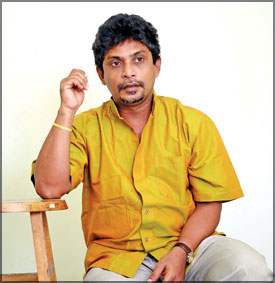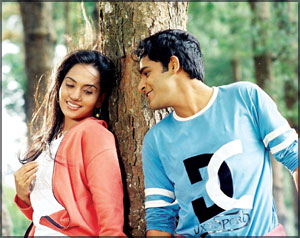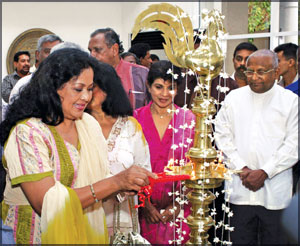
Smooth Sailing
Ratagedara on his slow and steady start in the movie
scene:
Ruwini JAYAWARDANA
Ever since he started his career in the spotlight as a child actor in
the critically acclaimed Madol Doowa in 1975, Dayaratne Ratagedara had
not looked back.
|

Director Dayaratne Ratagedara
Picture by Tennyson Edirisinghe |
The maker of innovative creations like Bogala Saundiris and Dekithi
Muwahath turned to the wide screen to give the Sinhala movie goers a
light-hearted romance suited for the whole family.
Through Nildiya Yahana, a host of new talent is introduced to cinema.
Young Saranga Disasekara who had made an impressive impact through
teledramas, makes his entry opposite the charming Chathurika Pieris. The
following are excerpts from an interview with director Ratagedara.
What were your expectations through Nildiya Yahana?
The movie is aimed at entertainment and giving the viewers a
worthwhile experience. The story merges with the contemporary society
and is put together by veterans as well as debutants. I hope the movie
will be a novel experience to the viewers and encourage a trend which
flows away from cheap fantasies and sex flicks.
What is your main focus in the movie? Teenage romance?
Nildiya Yahana deals with love but it is not only youth romance which
is highlighted but it also studies the bonds between parents and
children, siblings and friends. Some people have developed the wrong
notion that this movies is limited to youth but once you see that movie
you will realise that the whole family comes to light.
Each of us have passed some of these stages, one way or the other,
and experience helps to make successful creations. We have passed the
stages when lovers show affection by exchanging handkerchiefs and books.
Their techniques have become updated with technology and they are
able to communicate and express their love through SMS and at internet
chat rooms. I have also noticed that present day youth are compelled to
think and plan their future before proceeding with serious
relationships.
How did you decide on the title of the film as Nildiya Yahana?
Many people are puzzled over the title but once they have watched the
movie they realise that the whole story is connected with the mystery
lying below the deep waters of the Kandalama tank.
However some have misinterpreted the title and taken it as an adult
only theme. The script writer, Dileepa Jayakody, and I discussed and
decided on this name so that it will mirror the beauty of the romantic
tale which involves the plight of Shanuka and Shehara.
Why did you decide on a commercial film as your debut?
Cinema is an industry which should exist for many years. Novel and
interesting creations are needed to bring a punch to the industry. So I
did not ponder over the matter of making a commercial or artistic movie.
However some people have started to judge this film by comparing it with
my teledramas.
|

Saranga and Chathurika in a scene from Nildiya Yahana |
I have worked under many veterans in cinema as well as television
like Lester James Pieris, Ananda Hewage, Sarath Gunaratne, Sumithra
Peries, Sunil Ariyaratne, Tissa Abeysekara, Dhamma Jagoda, Parakrama
Niriella, Titus Totawatte, Lucian Bulathsinghala, Thilak Gunawardena and
many others as a make up artist as well as the assistant director and
those experiences helped in making this creation.
Nildiya Yahana is only a beginning and a new experience for me in my
venture into the movie scene. It does not mean I will continue making
creations in the same genre or theme in the future.
Many films flopped in the past while others, whom we did not pin much
hopes on, became extremely popular. My attempt was to make a movie based
on a simple tale which will be of interest to everyone. I believe I have
succeeded and I am satisfied with the outcome.
How is the audiences’ response to the film?
The response is quite overwhelming. I am grateful to movie
enthusiasts because despite the various difficulties of watching movies,
they have flocked to cinemas because of their love for the art.
The security situation, transport problems and lack of facilities at
the theatres limit the public from coming into film halls.
People prefer to stay at home and switch on their television rather
than going through the hassle of coming to theatre.
This situation needs to be changed for the survival of the industry.
The theatres should be upgraded so that people are tempted to come
and enjoy the facilities as well as watch a quality production.
If this situation continues, the 6.30 show in the afternoons will
soon be out of the scene.
The story of Nildiya Yahana is more like a fable. Was this based on a
true tale?
It is not taken directly form a fable but I have heard of stories
similar to this tale. I have been questioned as to why I ended the movie
by bringing death upon the two main characters.
The society still expects and prefer the traditional ‘ and they lived
happily ever after’ ending in every film.
What is your next project?
I haven’t decided on that yet but whatever I take up it will be
something different.
Sinhala Cinema 62 years young!
Sachitra Mahendra
National Film Corporation’s freshly built theatre was swarming with
movie enthusiasts on January 21 to give ear to Satischandra
Edirisinghe’s thoughts on Sinhala Cinema. With Sinhala cinema turning
62, Edirisinghe is able to sit back with the industry’s seasoned
generation.
|

Screen queen Malini Fonseka lights the oil lamp at the event
held to mark 62 years of Sinhala cinema . Minister of Cultural
Affairs and National Heritage Mahinda Yapa Abeywardena and
actress Nita Fernando are also in the picture. Picture by Malan
Karunaratne |
The evening stirred exotic memories of a classic era with both
Satischandra’s filmic thoughts and Tissa Nagodavithana’s lengthy
documentary that scanned the local reel from 1947 to 1968.
Satis, as he is fondly nicknamed in the art circle, was Judas in
Christu Charitaya, ‘The Christ’, co-starring Vijaya Kumaratunga. His
superb performance as the legendary character epitomizes the biblical
betrayal. Tissa Nagodavithana’s initials intrude on the beauty of old
hits. This is however a drop in the ocean thinking of Nagodavithana’s
unsurpassed contribution by preserving the old classics.
Satis likened the cinema history to Mahawamsa account of Lanka.
Mahawamsa does not traverse beyond Kuveni’s era. What Kuveni was
occupied with when Vijaya landed in, gives a hint on an uncharted rich
history.
The Sinhala cinema, in the same track, would not have had Kadavunu
Poronduwa, the Broken Promise, just fallen from the skies. Satis took
the grandstand back to 1930s, that era when the Leftist hardliner Dr N M
Perera performed in Rajakeeya Vikramaya, the ‘Royal Adventure’. It is
the bygone tale of a conspiracy of film burned to ashes in India.
“Wouldn’t it have been better to have the cinema inaugurated with
‘Royal Adventure’ rather than ‘Broken Promise’? But we had to face the
inevitable.”
Broken Promise, positively or negatively, stepped into Sinhala cinema
for record’s sake. It created history, which should be studied before
kicking around future. When Dudley Senanayake ruled the country, those
were Satis’ young days. Some movie magnates had seen Senanayake to have
a talk on cinema developments.
The Premier had the nerve to say that he had more important things to
think of than cinema, and of course he paid the price for being that
blunt: his opponent Mrs. B. had the blessings of the country’s arts
scene. Satis’ stage whispers are all this and then some.
Satis then started on a school for performance. “I remember how the
late Professor Sarachchandra kept on penning and speaking about a school
for performance. We are a decade ahead of his death, and still we talk
about a school.”
Satis had something for Transport Minister Dullas Alahapperuma as
well: mini-theatres. “I have seen many foreign stations having
mini-theatres with a large wall clock for people keep watch on train
schedules. You can take left-behind cabins for this purpose. You can
show old movies too. In a way it ensures passenger safety.”
The documentary on cinema history should have been a better
production, while Chairman Jayantha Dharmadasa, Consultant T M
Sanghadasa and Tissa Nagodavithana should have a pat on back for the
effort.
The documentary kicked off with a fascinating scene from the 62-year
old Kadavunu Poronduwa, and was on for well over two hours with film
chunks up to 1968. Documentary should have easily covered the movie
timeline up to 2008; only if the number of films a year were cut down
and some episodes were shortened. So much the better if a few minutes
were offered to Dr. Lester James Peries’ Rekhava as well.
The souvenir issued by the corporation to commemorate the anniversary
is a resourceful guide with rare information provided by Nuwan
Nayanajith. The back cover brings in the new era’s symbol for 2009 with
its portrayal of Sanath Gunathilake’s latest movie Ekamath Eka Rataka,
‘Once upon a country’.
Corporation’s Consultant T M Sanghadasa made a few references to
Mahinda Chinthana’s cinema policies. Businessmen burdened with annual
tax over Rs. 2-lakhs will be relieved when they invest on a film
production, is one option.
A peep into other languages films
K. S. Sivakumaran
Kannada is a Dravidian language spoken in the southern state of
India-Karnataka. One of the well known artistic filmmakers in that
language is Girish Kassaravalli.
He made a film in 2007 called Gulabai Talkies, which was shown in the
KFFI last December. This is a film made in a coastal fishing village in
Karnataka. It is an interesting film in that how modernization takes its
sweep in villages where the rural set-up is disturbed. But the story is
also interesting. How the director sees his film (he wrote the
screenplay also) would be authentic than my own perceiving.
|

Filmmaker
Girish Kassaravalli |
This is what gleaned from the synopsis:
Gulbai is a skilled midwife. She is the second wife of fish merchant
Musa. She is childless and much neglected but she is very popular among
the fisher folk as she is kind and helpful to others. She treats Musa’s
child by his first wife endearingly. Gulbai’s favourite pastime is
watching talkies (Cinema).
She is bewitched by the magic of cinema via the TV, She receives a TV
set. Her little hut becomes a talkies (theatre) as she invites everybody
in the neighbourhood to watch TV. So everybody irrespective of caste or
other differences flock into her small hut to watch the TV. The TV
programmes upset the minds and tastes of the naïve and poor fishing
community. Gulbai is a Muslim while the majority of the community
belongs to other religions.
The director adds: “Gulabai Talkies traces the impact of the new
media on a fishing community against the backdrop of globalized business
practices and growing communal tensions between Hindus and Muslims, at
the turn of the century.”
The film features ‘un-glamorised’ ordinary people.
Juju Factory is a French-speaking film from Congo. This film also
entertained me because it was about a writer, and publishers. The
writer’s name was Congo Kongo. He
was living in the African locality of Brussels but he had debts to
settle. He needed money. He went to a publishing house owned by two
whites (one was a woman) and an African. The latter guy has forgotten
his roots and wants Congo to write potboilers to please European
readers.
Such readers wanted exotic and mystical fiction from the Asian,
African and Latin American writers. Some of our Lankan writers,
especially those who live abroad, too write such exotic stuff and
internationally known.
Congo on the other hand wanted to write the history of Congo and its
relationship with Belgium. He was married but he had an unacknowledged
crush on one of her students who appreciated his writing.
There was a family crisis. In the meantime the other members of the
publishing company agreed to publish the book Congo wanted to write. The
student herself was an African beauty.
She too has a problem with her family because there was age
difference between the writer and the reader. The guy who was posing as
a pseudo European who had no stuff of his own was laid out. The language
spoken was French and all films at the festivals had subtitles in
English.
More about other films next week.
[email protected]
Akshay turns Kungfu expert
|

Akshay and Deepika in Chandni Chowk To China |
Chandni Chowk To China, the first ever Bollywood Kungfu comedy takes
you on a madcap Journey from the by-lanes of Chandni Chowk in Delhi, to
Shanghai, the Great Wall and rural China, marrying in its wake hilarious
gags, breathtaking action, spectacular locations and heart stirring
emotions.
Our protagonist Sidhu (Akshay Kumar) is the lowest on the totem pole,
cutting vegetables at a roadside food stall in Chandni Chowk in Delhi.
He longs to escape his dreary existence and looks for shortcuts- with
astrologers, tarot readers and fake fakirs - basically believing
anything except himself, despite his father figure Dada’s (Mithun
Chakraborty) best efforts.
His redeeming moment arrives when two strangers from China claim him
as a reincarnation of a war hero in the past and takes him to China.
Sidhu now dreams of wine, women, and a princely existence in foreign
lands.
The movie filled with laughter and adventure is directed by Nikhil
Advani. The movie, an EAP distribution, will unspool at Liberty cinema
from February 5. |



